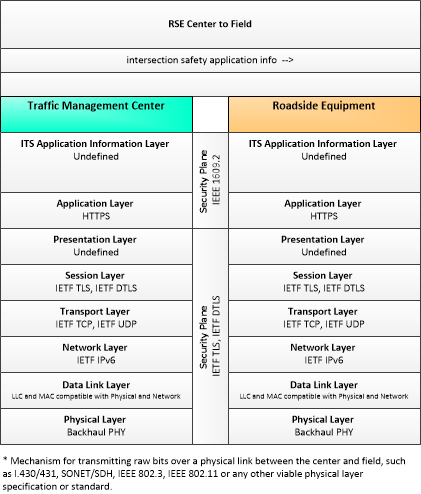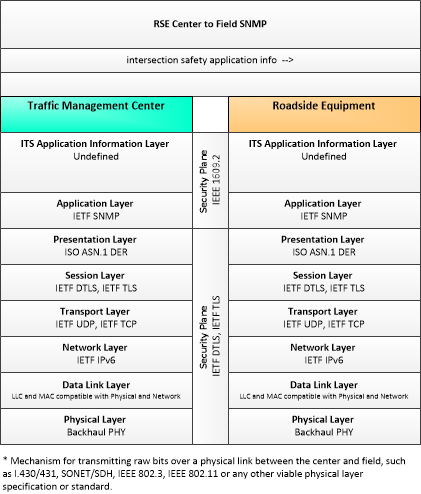Link Type: Center to Field
Traffic Management Center --> Roadside Equipment:
intersection safety application info
Definitions
intersection safety application info (Information Flow): Intersection and device configuration data and warning parameters and thresholds. This flow also supports remote control of the application so the application can be taken offline, reset, or restarted.
Traffic Management Center (Source Physical Object): The 'Traffic Management Center' monitors and controls traffic and the road network. It represents centers that manage a broad range of transportation facilities including freeway systems, rural and suburban highway systems, and urban and suburban traffic control systems. It communicates with ITS Roadway Equipment and Connected Vehicle Roadside Equipment (RSE) to monitor and manage traffic flow and monitor the condition of the roadway, surrounding environmental conditions, and field equipment status. It manages traffic and transportation resources to support allied agencies in responding to, and recovering from, incidents ranging from minor traffic incidents through major disasters.
Roadside Equipment (Destination Physical Object): 'Roadside Equipment' (RSE) represents the Connected Vehicle roadside devices that are used to send messages to, and receive messages from, nearby vehicles using Dedicated Short Range Communications (DSRC) or other alternative wireless communications technologies. Communications with adjacent field equipment and back office centers that monitor and control the RSE are also supported. This device operates from a fixed position and may be permanently deployed or a portable device that is located temporarily in the vicinity of a traffic incident, road construction, or a special event. It includes a processor, data storage, and communications capabilities that support secure communications with passing vehicles, other field equipment, and centers.
Included In
This Information Flow is in the following Applications:
- Pedestrian in Signalized Crosswalk Warning
- Pedestrian Mobility
- Red Light Violation Warning
- Stop Sign Violation Warning
This Information Flow is in the following Application Objects:
Communication Diagrams
The communication diagram(s) can be viewed in SVG or PNG format and the current format is SVG. Switch to PNG format.
This profile identifies applicable standards for Center to Field communications with RSEs. This profile uses the Simple Network Management Protocol (SNMP), an Internet-standard protocol for managing devices on IP networks.
Characteristics
Architectural:
| Characteristic | Value |
|---|---|
| Time Context | Recent |
| Spatial Context | Local |
| Acknowledgement | True |
| Cardinality | Unicast |
| Initiator | Destination |
Security
This information flow triple is in the following applications with the following security levels.
| Information Flow Security | |||||
|---|---|---|---|---|---|
| Application | Confidentiality | Integrity | Availability | ||
| Basis | Basis | Basis | |||
| Pedestrian in Signalized Crosswalk Warning | Moderate | Moderate | Low | ||
| o Application configuration: The messages sent from the RSE are public and the warning parameters can be assumed to follow widely-known industry best practices, so management messages to configure these do not have a significant confidentiality requirement. o Device management: As with TMC: Pedestrian Safety Warning Control, the device management may include proprietary information about the particular device being managed such as firmware details, memory size, processor limitations etc. The confidentiality requirement for the roadway equipment should be set by the supplier based on their understanding of the confidentiality requirements of the management messages. Note that the supplier can be assumed to provide devices that meet their own security requirements; however, the confidentiality requirements of this flow will also apply to the TMC. |
Fake instances of this information flow can cause drivers and pedestrians to get incorrect information (for example, swap the "safe to cross" and "not safe to cross" messages so pedestrians are told to cross when it isn't safe). In particular, visually impaired people may rely on the message content to cross safely and may be endangered by bad message content. However, the impact is limited to a single crossing area and drivers still have primary responsibility for the safety of vulnerable road users, so the integrity requirement is MEDIUM rather than HIGH. | Assuming that the traffic signal is configured reasonably well to start off with, the system should be robust if it goes an arbitrary amount of time without reconfiguration. | |||

